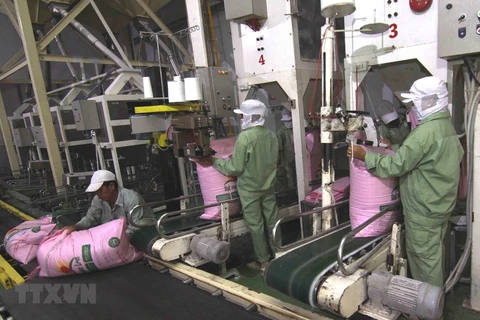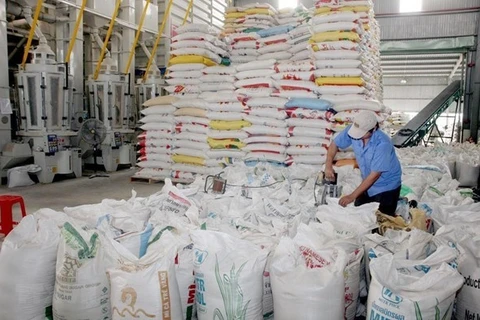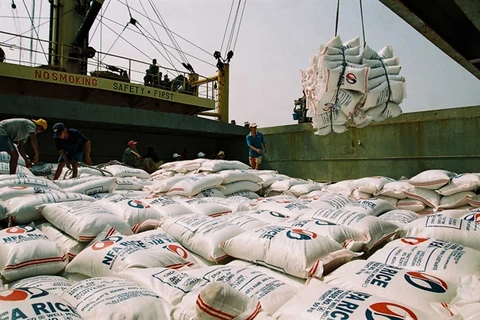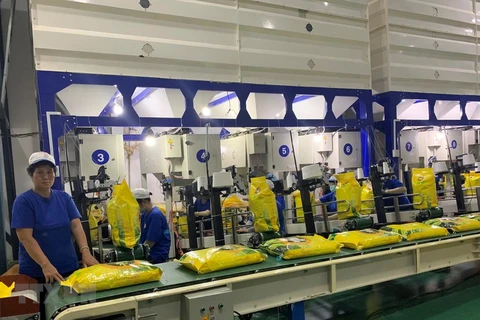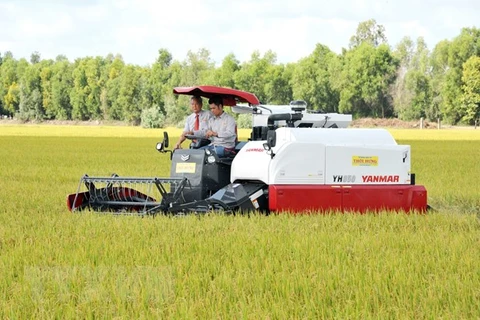 Farmers in My Lam commune in Hon Dat district of the Mekong Delta province of Kien Giang dry their newly harvested rice from the winter-spring crop. (Photo: VNA).
Farmers in My Lam commune in Hon Dat district of the Mekong Delta province of Kien Giang dry their newly harvested rice from the winter-spring crop. (Photo: VNA). Hanoi (VNA) - Thanks to tireless efforts, Vietnam has not only ensured domestic food security but also turned rice into a billion-dollar export item, helping the country to become one of the leading rice exporters in the world.
Impressive achievements
Rice is one of the strengths of Vietnam's agriculture and plays an important role in the country's socio-economic development.
Before 1989, Vietnam still had to import rice, but in 1989, Vietnam exported 1.42 million tonnes of rice to international markets.
In 2019, Vietnam shipped 6.37 million tonnes of rice, raking in 2.81 billion USD. In 2020, the export price of rice increased sharply, so even though the country’s output decreased by nearly 2.5 percent, the total export turnover still reached 3.07 billion USD, ranking 2nd in the world, just after India.
In 2021, despite the impact of the COVID-19 pandemic, rice continued to be Vietnam's main export agricultural product, with a total export turnover of nearly 3.3 billion USD.
In addition to impressive achievements in output and export turnover, Vietnam has recorded a strong shift in the structure of export rice varieties towards producing high-value-added rice varieties such as fragrant, japonica and speciality rice.
Increasing the quality of rice is one of the most important factors helping promote the value of exported rice.
Vietnam has exported rice to about 80 countries and territories worldwide, of which Asia is still the main market, followed by the African market. The largest importers of Vietnamese rice are the Philippines, China, Malaysia, Ghana, Cote d'Ivoire, Iraq, Indonesia, Hong Kong (China), and Senegal.
The agricultural restructuring process has helped Vietnamese rice make inroads into more demanding markets besides traditional markets.
Thanks to new-generation free trade agreements (FTAs) Vietnam signed with partners, such as the Comprehensive and Progressive Agreement for Trans-Pacific Partnership (CPTPP) and the EU-Vietnam Free Trade Agreement (EVFTA), Vietnam has more opportunities to export rice to new markets.
Notably, Vietnamese rice is also constantly named at the top of the World's Best Rice contest. Organised by The Rice Trader, Vietnam's ST 25 rice was honoured as the world's best rice in 2019, and the world's second-best in 2020.
Improving quality to promote position of Vietnamese rice
According to the Ministry of Agriculture and Rural Development (MARD), despite achieving remarkable results, Vietnam's rice industry is also facing many challenges due to low efficiency and the impacts of climate change, especially in the Mekong Delta - a key rice producing region of the country.
To meet the new requirements for more sustainable development of the rice industry, MARD has approved the rice sector restructuring to 2025 and 2030.
Vietnam aims to maintain the rice land area from 3.6 – 3.7 million hectares, and produce between 40-41 million tonnes of rice by 2025. The country is set to produce a minimum of 35 million tonnes of rice, and export about 4 million tonnes per year by 2030.
To that end, MARD has recommended limiting conversion in areas where rice land is highly fertile and complete irrigation systems, as well as ending the practice of allowing rice land to fallow.
The ministry underlined the need to flexibly shift rice cultivation areas in the direction of increasing the ratio of the rotational rice area (with vegetables and aquatic products) to meet the needs of the market.
The Mekong River Delta is most heavily affected by climate change. It must develop rice cultivation models that adapt to climate change; improve the value and efficiency through improving rice quality and expanding production-consumption linkage and boosting export.
Vietnam will continue to implement a rice export strategy in the 2017-2020 period with a vision until 2030.
The agriculture sector will concentrate on strengthening the selection and development of rice varieties to meet the structure of rice varieties following the export strategy, with priority given to fragrant and speciality rice varieties and the development of concentrated production areas in line with varieties identified.
Attention will be paid to strictly controlling the production process so that products have uniform quality, and ensure food safety and hygiene standards.
To ensure the high efficiency of rice exports, policies to support exporters with national brand and label of certification “Vietnamese Rice” have been concretised. Offices to introduce Vietnamese rice in key markets have been established.
According to MARD, advantages brought by FTAs should be fully tapped to develop rice export markets, especially introducing Vietnamese rice in markets requiring high-grade rice segments.
Implementing a plan to promote Vietnamese rice, the 5th Vietnam Rice Festival will be held from January 7 - 10 in the Mekong Delta province of Vinh Long.
The event will provide opportunities to promote product introductions and trade connections among rice businesses. It also aims to honour the value of rice and the important role of rice growers./.

